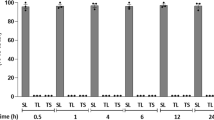Abstract
Gangliosides of the ‘GM1b-pathway’ (GM1b and GalNAc-GM1b) have been found to be highly expressed by the mouse T lymphoma YAC-1 grown in serum-supplemented medium, whereas GM2 and GM1 (‘GM1a-pathway’) occurred only in low amounts [Müthing, J., Peter-Katalinić, J., Hanisch, F.-G., Neumann, U. (1991)Glycoconjugate J 8:414–23]. Considerable differences in the ganglioside composition of YAC-1 cells grown in serum-supplemented and in well defined serum-free medium were observed. After transfer of the cells from serum-supplemented medium (RPMI 1640 with 10% fetal calf serum) to serum-free medium (RPMI 1640 with well defined supplements), GM1b and GalNAc-GM1b decreased and only low amounts of these gangliosides could be detected in serum-free growing cells. The expression of GM1a was also diminished but not as strongly as that of GM1b and GalNAc-GM1b. These growth medium mediated ganglioside alterations were reversible, and the original ganglioside expression was achieved by readaptation of serum-free growing cells to the initial serum-supplemented medium. On the other hand, a ‘new’ ganglioside, supposed to represent GalNAc-GD1a and not expressed by serum-supplemented growing cells, was induced during serum-free cultivation, and increased strongly after readaptation. These observations reveal that the ganglioside composition ofin vitro cultivated cells can be modified by the extracellular environment due to different supplementation of the basal growth medium.
Similar content being viewed by others
References
Hakomori S (1984) inThe Cell Membrane (Habes, E. ed.) pp. 181–201 New York: Plenum Press.
Müthing J, Schwinzer B, Peter-Katalinić J, Egge H, Mühlradt PF (1989)Biochemistry 28:2923–9.
Yohe HC, Coleman DL, Ryan JL (1985)Biochim Biophys Acta 818:81–6.
Saito M, Nojiri H, Yamada M (1980)Biochem Biophys Res Commun 97:452–62.
Ohsawa T, Nagai Y (1982)Exp Geront 17:287–93.
Ohsawa T (1989)Exp Geront 24:1–9.
Rössner H, Greis C, Rodemann HP (1990)Exp Cell Res 190:161–9.
Kawaguchi T, Takaoka T, Yoshida E, Iwamori M, Takatsuki K, Nagai Y (1988)Exp Cell Res 179:507–16.
Iber H, van Echten G, Klein RA, Sandhoff K (1990)Eur J Cell Biol 52:236–40.
Niimura Y, Ishizuka I (1990)Biochim Biophys Acta 1052:248–54.
Müthing J, Jäger V (1991) 15th International Congress of Biochemistry, Jerusalem, Israel.
Bergelson LD, Dyatlovitskaya EV, Klyuchareva TE, Kryukova EV, Lemenovskaya AF, Matveeva VA, Sinitsyna EV (1989)Eur J Immunol 19:1979–83.
Müthing J, Peter-Katalinić J, Hanisch FG, Neumann U (1991)Glycoconjugate J 8:414:23.
Samoilovich SR, Dugan CB, Macario AJL (1987)J Immunol Methods 101:153–70.
Barnes D (1987)BioTechniques 5:534–42.
Jäger V, Lehmann J, Friedl P (1988)Cytotechnology 1:319–29.
Müthing J, Egge H, Kniep B, Mühlradt PF (1987)Eur J Biochem 163:407–16.
Ueno K, Ando S, Yu RK (1978)J Lipid Res 19:863–71.
Ladisch S, Gillard B (1985)Anal Biochem 146:220–31.
Williams MA, McCluer RH (1980)J Neurochem 35:266–9.
Müthing J, Mühlradt PF (1988)Anal Biochem 173:10–7.
Kasai M, Iwamori M, Nagai Y, Okumura K, Tada T (1980)Eur J Immunol 10:175–80.
Hirabayashi Y, Koketsu K, Higashi H, Suzuki Y, Matsumoto M, Sugimoto M, Ogawa T (1986)Biochim Biophys Acta 876:178–82.
Young WW Jr, MacDonald EMS, Nowinski RC, Hakomori S (1979)J Exp Med 150:1008–19.
Bethke U, Müthing J, Schauder B, Conradt P, Mühlstein PF (1986)J Immunol Methods 89:111–6.
Müthing J, Ziehr H (1990)Biomed Chromatogr 4:70–2.
Magnani JL, Smith DF, Ginsburg V (1980)Anal Biochem 109:399–402.
Nakamura K, Suzuki M, Inagaki F, Yamakawa T, Suzuki A (1987)J Biochem (Tokyo)101:825–35.
Schauer R, Veh RW, Sander M, Corfield AP, Wiegandt H (1980)Adv Exp Med Biol 125:283–94.
Wu G, Ledeen R (1988)Anal Biochem 173:368–75.
Svennerholm L, Mansson JE, Li YT (1973)J Biol Chem 248:740–2.
Cuatrecasas P (1973)Biochemistry 12:3547–58.
Fishman PH, Pacuszka T, Hom B, Moss J (1980)J Biol Chem 255:7657–64.
Otnaess ABK, Laegreid A (1986)Curr Microbiol 13:323–26.
Cumar FA, Maggio B, Caputto R (1982)Mol Cell Biochem 46:155–60.
Holmgren J, Elwing H, Fredman P, Svennerholm L (1980)Eur J Biochem 106:371–9.
Fishman PH (1982)J Membrane Biol 69:85–97.
Fishman PH, Moss J, Richards RL, Brady RO, Alving CR (1979)Biochemistry 18:2562–7.
Laine RA, Hakomori S (1973)Biochem Biophys Res Commun 54:1039–45.
Fishman PH, Moss J, Vaughan M (1976)J Biol Chem 251:4490–4.
Magnani JL, Nilsson B, Brockhaus M, Zopf D, Steplewski Z, Koprowski H, Ginsburg V (1982)J Biol Chem 257:14365–9.
Tsuchida T, Ravindranath MH, Saxton RE, Irie RF (1987)Cancer Res 47:1278–81.
Author information
Authors and Affiliations
Additional information
Abbreviations: BSA, bovine serum albumin GSL(s), glycosphingolipid(s); HPTLC, high-performance thin-layer chromatography; LDL, low density lipoprotein; NeuAc,N-acetylneuraminic acid; NeuGc,N-glycoloylneuraminic acid. The designation of the following glycosphingolipids follows IUPAC-IUB recommendations. GgOse3Cer or gangliotriaosylceramide, GalNAcβ1-4Galβ1-4GlcCer; GgOse4Cer or gangliotetraosylceramide, Galβ1-3GalNAcβ1-4Glaβ1-4GlcCer; GgOse5Cer or gangliopentaosylceramide, GalNAcβ1-4Galβ1-3GalNAcβ1-4Galβ1-4GlcCer; GgOse6Cer or gangliohexaosylceramide, Galβ1-3GalNAcβ1-4Galβ1-3GalNAcβ1-4Galβ1-4GlcCer or GgOse6Cer; II3NeuAc-GgOse3Cer or GM2; II3NeuAc-GgOse4Cer or GM1 or GM1a; IV3NeuAc-GgOse4Cer or GM1b; IV3NeuAc-GgOse5Cer or GalNAc-GM1b; IV3NeuAc-GgOse6Cer or Gal-GalNAc-GM1b; IV3NeuAc, II3NeuAc-GgOse4Cer or GD1a; II3(NeuAc)2-GgOse4Cer or GD1b; IV3NeuAc, III6NeuAc-GgOse4Cer or GD1a; IV3NeuAc, II3NeuAc-GgOse5Cer or GalNAc-GD1a.
Enzymes: Vibrio cholerae andArthrobacter ureafaciens neuraminidase (EC 3.2.1.18).
Rights and permissions
About this article
Cite this article
Müthing, J., Pörtner, A. & Jäger, V. Ganglioside alterations in YAC-1 cells cultivated in serum-supplemented and serum-free growth medium. Glycoconjugate J 9, 265–273 (1992). https://doi.org/10.1007/BF00731138
Received:
Revised:
Issue Date:
DOI: https://doi.org/10.1007/BF00731138




